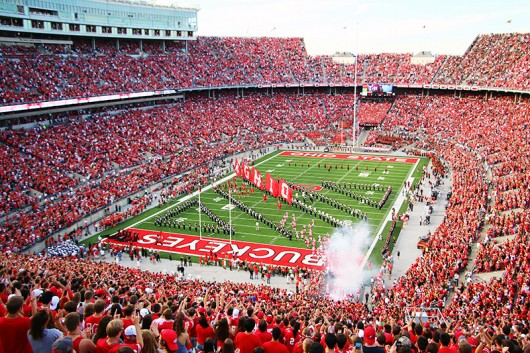
Fans cheer as players run onto the field at Ohio Stadium before a game. Credit: Lantern file photo
Seven times each fall, more than 100,000 fans and students flock to Woody Hayes Drive to spend a few hours in Ohio Stadium for game day.
Few realize just how much time, effort and planning goes into hosting games at the nation’s third largest college football stadium, or, more importantly, how the waste of more than 100,000 people gets cleaned up in time for the next game.
Mike Smith is the coordinator of building services for Ohio Stadium and he’s helped keep the ‘Shoe running for more than 12 years. Part of his role includes managing the operations team, which is a small student-employee workforce that keeps the stadium clean and ready for each home game and event.
Smith knows better than anyone how much behind-the-scenes work goes into preparing for an event with so many patrons.
“What goes into it … having an event happen, I didn’t even realize it until I started working here,” Smith said.
Smith’s game day begins about eight hours before each kickoff as he helps law enforcement officers conduct a security sweep of the stadium. This early-morning walkthrough lasts anywhere from three to four hours, and, after the ‘Shoe is deemed safe, the full stadium crew begins to arrive.
“We have 28 to 30 students on staff, and that’s just operations,” he said.
These student employees work throughout the week and help to keep Ohio Stadium clean and prepared for upcoming events. Working around the class schedules of 30 students throughout the week requires a lot of flexibility, but Saturdays and Sundays are mandatory for every staff member.
In the hours before the game, Smith and his crew work to put the finishing touches on the stadium before the gates open. This includes setting up benches, fans, pylons and field goal nets on the field as well as barricades, trash cans and signs at each and every gate.
The operations staff works throughout the week to make sure the stadium is ready ahead of time to minimize the work that needs to be done on Saturday morning.
Once the game kicks off, most of the student crew can relax while Smith continues his management role. While the Buckeyes play, Smith has to be ready for any potential issue that might arise within the facility.
“Any building issues, say an elevator stops or has an issue … or any lighting issues, we have personnel on standby,” he said.
Smith and his team don’t stay long after games, usually just an hour after each game. Once the fans leave, they return bright and early on Sunday to begin the real work: cleanup.
Weather permitting; the cleanup crew arrives around 6 a.m. Sunday mornings to begin the bulk of the cleanup joined by the members of the Naval Reserve Officers Training Corps.
“ROTC, which is our main, bulk cleaning group, they bring over 100 to 120 people and, basically, they are our workforce,” Smith said.
This work has been a mandatory part of the NROTC program for quite some time.
“It’s been us for decades,” said Midshipman Craig Heim, a third-year in aerospace and astronautical engineering. “There’s been alumni, who are active-duty Navy now, who have come back and asked, ‘Do you guys still clean the stadium?’”
This NROTC workforce allows the stands to be cleared of trash and debris in just five to six hours each Sunday morning.
“They do a great job,” Smith said. “They hand pick (trash) because of our Zero Waste program … they’ll have a recycling bag and a compost bag.”
During the 2010 season, Ohio Stadium diverted 46 percent of all the waste generated at home games from landfills. By the 2015 season, four years after the start of the Zero Waste program, more than 96 percent of all waste created in the ‘Shoe was diverted from landfills and diverted to nearby recycling and composting centers.
This sustainability campaign was a massive undertaking and, at first, Smith admitted there was a learning curve to the new processes for his team. But now, it is second nature.
“It doesn’t take too much longer,” Smith said. “It did initially, but you work through it to come up with new ideas and different tactics.”
Even with more than 100 volunteers to help out, the cleanup work continues throughout the week. Smith and his crew work daily to make sure the stadium stays spotless and remains ready for the next game or event.
Not only does Smith have to plan around the work availability of his student staff members, he also has to plan for other events that might be scheduled during the season.
“Sometimes clean up on Sunday morning is actually scheduled for Saturday after the game so we’re ready for an event we might host on Sunday,” Smith said.
Even back to back home weeks create additional challenges for Smith and his team.
“Back to backs are a higher paced week,” Smith said. “It’s some longer hours during the week to try and catch up to get it the way it needs to be for the next game.”
Last year, in a football season that included five home games in a six week stretch, Ohio Stadium hosted more than 750,000 guests — and that’s just for football games.
When considering all the additional private gatherings, events and concerts that take place in the stadium throughout the year, more than one million visitors pass through the gates of the ‘Shoe each year.
As Smith notes of the work he does with his staff, “We’re more of behind the scenes.”
This might be true during the week leading up to home games, but on those fall Saturdays the ‘Shoe and all the crew’s hard work takes center stage, if only for a few hours.


